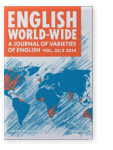Vol. 35:2 (2014) ► pp.193–224
Between you and I
Case variation in coordinate noun phrases in Canadian English
Variable case marking of pronouns in coordinate noun phrases (CoNPs) is a well-documented phenomenon which has elicited prescriptive censure for centuries. Drawing on the framework of variationist sociolinguistics, this study presents a detailed quantitative analysis of variable case marking in CoNPs in the Quebec English Corpus (Poplack, Walker and Malcolmson 2006), a massive compendium of vernacular speech. Operationalizing a number of extralinguistic and linguistic factors that are claimed to condition variable case marking in CoNPs, multivariate analysis revealed that speaker age and education as well as the syntactic position of the CoNP are key predictors in determining the case of pronouns in these constructions. An important finding is that case marking in CoNPs is highly variable for speakers, suggesting that the Sisyphean efforts of the prescriptive enterprise to impose uniformity on this area of the grammar have been to little avail as far as spontaneous usage is concerned. Comparison of the results with variable case marking in CoNPs in other varieties of English, as well as with diachronic patterns of variability, also raises the possibility that the accusative is increasingly assuming the role of default case in coordinate constructions.
